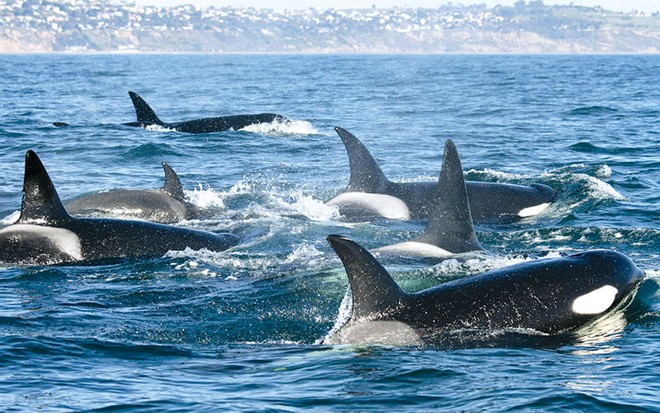Whales, whales and more whales in Southern California
by The Log/Sail-World Cruising on 3 Feb 2012

Family Gathering -- A pod of orcas known as CA51 has made a habit of traversing farther south than most killer whales, being spotted multiple times over the years hunting and playing along Southern Californias coastline. The group was seen traveling with another orca family (CA140) Jan. 2 off Palos Verdes, and again Jan. 10 off Dana Point. -- Alisa Schulman-Janiger photo SW
Sailors in Southern California are being treated to the magnificent sight of hundreds of whales off the coastline this year,quoted as the best sightings in 10 years. Gray whales are migrating south in record numbers and killer whales -- or orcas -- are also making sporadic showings.
Whale-watching charter vessels from San Diego to Santa Barbara have reported to The Log that multiple gray and finback whale sightings, and large pods of orcas have been appearing right alongside boats, in some cases.
'There haven’t been many days lately where we haven’t seen a whale,' said Dan Johnson of Dana Wharf whale watching tours. Johnson, who spent 16 years as a deckhand on charter boats operating out of Dana Point Harbor, said that the past year has been stellar for whale watchers.
'Last year, we had all of those blue whale sightings from May through October, and then the gray whales came along a little earlier in their migration than usual,' Johnson said.
Not only did the whales arrive earlier, but they came in much higher numbers than usual, according to Alisa Schulman-Janiger of the American Cetacean Society.
'We’re seeing about double what we saw at this point last year,' Janiger said in an interview with www.thelog.com!The_Log on Jan. 10. 'We were even getting reports of grays showing in October -- and these reports are coming in from up and down the coast, from Monterey to San Diego.'
Janiger oversees the gray whale census and behavior project at the Los Angeles branch of the American Cetacean Society, where -- since 1979 -- designated spotters have located and recorded whale activity off Palos Verdes Peninsula from their deck at the Point Vicente Interpretive Center.
Each winter, gray whales migrate south along the coast from the frigid waters of Alaska to nursery grounds off Baja California, where pregnant females give birth to a new generation of whales.
In December, when southbound whale sightings usually start picking up, 198 gray whales were spotted -- nearly triple the normal sightings, according to the survey’s 10-year average. While the increase in whale activity has whale lovers overjoyed, scientists are wondering what, exactly, is causing the influx in numbers.
'It does fluctuate, depending on the year,' said Jessica Crawford, a marine biologist at San Diego’s Birch Aquarium told The Log. 'On average, we tend to see most going southward at the end of January into early February, but were pleasantly surprised to see them earlier than usual and in greater numbers. We were seeing upward of 15 to 20 grays a day.'
Biologist Wayne Perryman of the National Marine Fisheries Service has a hunch about why the numbers are increasing: Two good feeding seasons in a row in Arctic waters could be resulting in a larger number of pregnant whales coming south to give birth, along with an increase in fattened-up females coming south, ready to get pregnant for next year (as gray whales often breed on the southward migration).
Starting early this month, the gray whales will begin heading back north to the feeding grounds with their newborn calves, giving boaters and other whale watchers another opportunity to point and marvel. However, the migration also gives orcas a chance to feed on some of those calves.
Orcas, which have rightfully earned the name 'killer whales,' have been known to prey on newborn calves as they begin the long migration north. While usually remaining north of Monterey, some families of orcas have begun moving south along the Los Angeles County and Orange County coast.
One orca family known as CA51 (the whale groups are numbered from 1 to more than 200), was first seen off California in 1991 and has become known as the 'transient' pod, ranging up and down the coast.
The seven-member family -- which consists of the mother, four offspring and two calves belonging to one of the daughters -- usually stays around Monterey Bay, but it has been known to take detours south. It was spotted off Malibu in 2007 and 2008, and it was sighted multiple times in 2010.
This season, the CA51 group has made many appearances in Southern California since December -- showing up off Ventura, Newport Beach, Dana Point and Palos Verdes, sometimes with other orca family groups.
It's important to keep a safe distance from whales -- at least 100 feet. Boats should never cut in front of -- or separate -- groups of whales.
If you want to link to this article then please use this URL: www.sail-world.com/93534